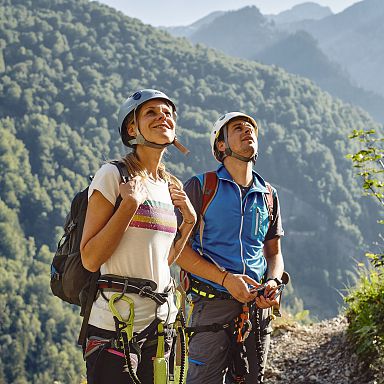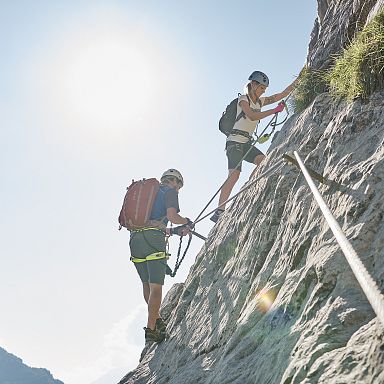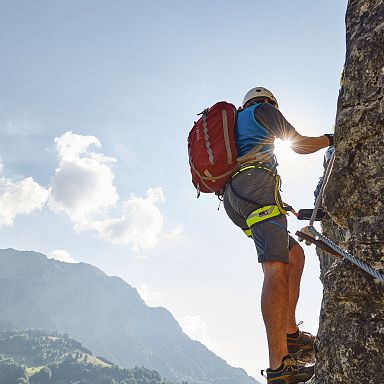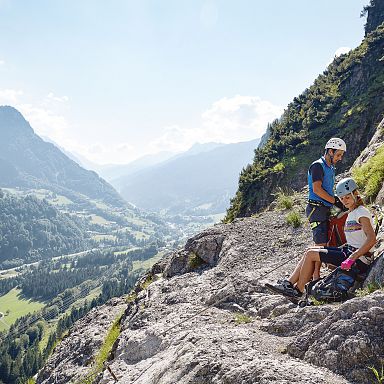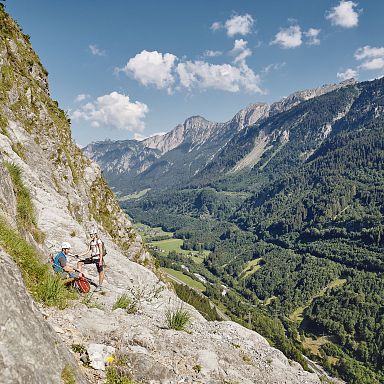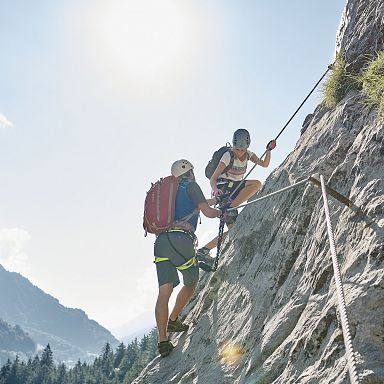Klostertal Via Ferrata on the Fallbach
At the mighty Fallbach Wall with builder Roland Vierhauser
My eyes roam over the rugged rock. The enormous rock face above me seems almost endless, just as endless as the abyss that opens up below me. The only thing that seems just as limitless is the breathtaking view over the fabulous Klostertal and the mighty peaks towering behind my back. Only the queen of the peaks - the "Rote Wand" - is still hiding from me, waiting until I have gained enough height to enjoy the sight of it. Unlike my companion Roland Vierhauser from "Seilarbeit Austria" - builder and maintainer of the via ferrata - I'm hanging out in the Fallbach wall for the first time today. Roland not only hangs out here in summer, but has also climbed the waterfall - or rather the icefall - in winter. There is one of the longest ice tours in Austria on the Fallbach wall. However, the days with good ice conditions are becoming fewer and fewer every year. But this undertaking is left purely to the professionals. The Klostertal via ferrata on the Fallbach, on the other hand, is absolutely not for beginners, but for amateur climbers like me it is a true experience! This undertaking is all the more exciting when you get to experience it together with mountain guide Roland - because interesting insider knowledge and background information are definitely not missed out on during our tour together!
Roland Vierhauser is a mountain and ski guide with a passion - especially in winter he is at home in the alpine wilderness of the Arlberg. While he used to travel a lot in the Western Alps, the family father now devotes himself mainly to industrial climbing in summer and thus builds via ferratas, among other things. In just eight days, the five-man team around "Seilarbeit Austria" transformed the mighty 600 m wall into an adventure for via ferrata fans. With all my strength I try to wind my way along the rock face. A slightly overhanging passage demands all my skills - just before the next rope clip my heart starts to pound, I quickly hook on one carabiner after the other. Phu, I made it! Even though a fall on the via ferrata would be fatal either way, I feel a little relieved every time I arrive at another rope clip and have put on the via ferrata set. It's unimaginable how Roland and his team were hanging on this mighty wall - and that was before steel ropes and holds provided the necessary safety. Roland remembers back to 2018: "Back then during the construction, everything went smoothly. We really are a well-coordinated team. But of course we also took precautions for our own safety. First, the entire line was laid with static rope. Not only for the fact that we could secure ourselves somewhere, but also as an escape route, for example in case of approaching thunderstorms." Looking at the abyss, I feel a shiver down my spine just thinking about having to leave this wall in a hurry. There would be no quick escape or emergency exit here anyway, so it is all the more important to plan the tour correctly, especially with regard to the weather. Especially during thunderstorms, staying along a steel cable in a rock face would be extremely problematic. But fortunately this cannot happen to us today, because Roland has ordered the best weather.
Again I grab the rope, a step on one of the few iron steps helps me over a difficult passage. "Did you carry all the material up here?" I ask Roland. But that would be rather utopian. Of course, a helicopter helped with the via ferrata. A total of four material depots were set up, from which the materials were then transported from the top to the bottom to the designated sequences - but I can't elicit more detailed details about the construction from Roland - after all, we are talking about company secrets here, so to speak.
The entire Fallbach Wand stretches over a height of more than 600 m and a width of about 1,400 m from Dalaas (Winkel) to Braz. In this mighty wall there would probably be many possibilities to draw a line. How did they come up with the idea of building the via ferrata here, of all places, where we are climbing right now? "In the run-up, possible lines were already determined in theory," says Roland, "see that spot up there?", Roland points to an area in the via ferrata, "we dismantle this section in winter because the snow pressure would be too great. And it was precisely according to this factor, among others, that the line was chosen. From winter photos we could see where there is the most snow and therefore the most pressure. Of course, we tried to avoid these places." Even though many details were thought out and planned beforehand, the final line is decided on the spot, Roland reveals. This happened during the via ferrata construction in May 2018. In April, however, another "campaign" took place: "Two of us abseiled our way through the entire Fallbach wall to check whether our previously determined line was feasible. The rock is good, but it's still a huge wall. There is always movement here!" The Fallbach wall is made of dolomite rock, which is closely related to limestone. This carbonate rock is considered extremely climbing-friendly. Of course, this is just to my advantage, because the climb winds mainly along the rock formations and mostly dispenses with unnecessary iron aids. The character of the via ferrata is therefore very natural. Here you don't climb up iron stairs, but use the natural rock with its cracks and edges to move around.
Suddenly I feel drops! Is it raining? Worried, I look up at the sky, but apart from bright blue and a few birds circling, I can't see anything. No trace of rain. "That's because of the waterfall," Roland explains, "we are now approaching my favourite section - the lake spray. Depending on the wind direction, you can get a few drops here when there's a lot of water." Given the warm temperatures, this is really very refreshing. We come to a cosy resting bench where we take a break and enjoy the view of the Klostertal valley. Gradually, more and more villages become visible - in the beginning, we only saw Dalaas, now we almost have the whole valley in view. As we continue, we get very close to the water and can observe how the rivulets literally snake down the rocks. The Klostertal via ferrata on the Fallbach has truly earned its name. "But it's not like this at every time of year," the mountain guide remarks, "We've just had a period of bad weather. Otherwise, at this time of year, it can be that the waterfall hardly has any water. That's why I recommend the via ferrata especially in spring, when the snow is still melting. Not only the waterfall shows its most beautiful side then, but also the colourful blossoms on the rock - that surprises most people!"
Even though the path is still so beautiful, exhaustion slowly sets in. After the first half, you think you're at the end of the trail, but then suddenly another torrent wall appears from above. After See Spray we are just over halfway and come to the Dirty Shoe Comer - section 4. I wonder why this section got this name - do you get your shoes dirty here? But after a few metres I see the namesakes - shoes! Two pairs of dirty shoes hang on the wall, secured with a rope on a hook. I wonder if they are put up again every season. I wonder who the shoes belong to? Another detail catches my eye: It seems as if the climb once ran a bit further to the right. There is still steel in the rock here. "This is where the original via ferrata ran," Roland explains, "after the first season there was an incident, which is why we had to close the via ferrata again for the time being and subsequently moved it a bit." What could have triggered this closure? Again Roland points to a spot, but not in the via ferrata, but more than a hundred metres away. "There was a massive rockfall up there," Roland informs us. But how can a rockfall at this distance cause damage to the via ferrata? "About 100 metres from the facility was damaged by rocks which were shattered by an impact. The damage was quickly repaired, but we asked ourselves the question: how do we deal with this geological problem area?" The via ferrata was then closed. Geologists inspected the Fallbach wall and the decision was made to blast it. After the problematic rock section was blasted, they waited another winter. After numerous further inspections by geologists and industrial climbers, the Klostertal via ferrata on the Fallbach was reopened in 2020. Since then, there have been no more incidents. Nevertheless, in alpine, rocky terrain it can of course always happen that stones fall down. That is why it is always important to wear a helmet.
With a big kick I climb further up, the trees and the bushes at the end of the path are getting closer. "Now you'll soon have made it," says Roland. My companion knows the via ferrata inside out. I wonder how many times he has done it. "I stopped counting at some point," Roland replies, "I'm here every now and then - either for work, for mountain rescue exercises, as a mountain guide with guests or privately with my children." Wow, Roland's children can already manage this mighty via ferrata! But what happens when it gets too much for someone? "The good thing about the via ferrata is that the most difficult part is right at the beginning. Here we sort it out straight away. If someone overestimates themselves, they still have the option of turning around, and many people use this option." That's really a good feature of a via ferrata, I think to myself. That's why it's all the more important to assess yourself well and approach such an undertaking with the necessary respect. "Take your time! Rest in the flat parts so that you have enough strength for the steep passages. There are many inviting rest areas, use them! That's my message to everyone," says Roland as we climb the last few metres. At the top, I enjoy the view for a short while before heading out into the forest. And there it is at last - the Rote Wand. From this perspective it is immediately clear why it is called the Red Wall. "I did it!" I gasp in relief. "Not quite yet," says the mountain guide. "It's only ever done when you're back home." During the descent, I remember Roland's words, because this one has a lot in it! Here, too, full concentration is still required. At the bottom, I say goodbye to Roland Vierhauser and his exciting stories.
Author: Angelina Holzer


